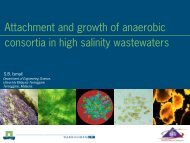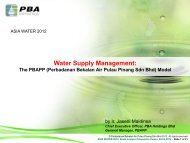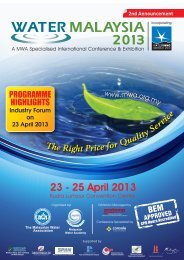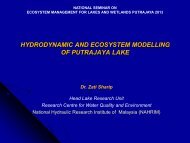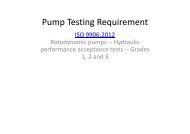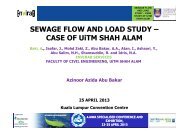Mr. Lau Hieng Ung, Director, Sewerage Services Department Sarawak
Mr. Lau Hieng Ung, Director, Sewerage Services Department Sarawak
Mr. Lau Hieng Ung, Director, Sewerage Services Department Sarawak
- No tags were found...
Create successful ePaper yourself
Turn your PDF publications into a flip-book with our unique Google optimized e-Paper software.
GE’s Biological Wastewater TreatmentSystem to Help Coal-Fired Power PlantRemove SeleniumGE has announced that AmericanElectric Power (AEP) is installingGE’s ABMET® wastewater bioreactorsystem at the utility’s Mountaineercoal-fueled power plant in New Haven.GE’s proprietary biological treatmentsystem uses a special molasses-basedproduct as a nutrient for microbes thatreduce selenium, a constituent foundin many coal-fired power plant wateremissions.GE’s ABMet technology utilises specialstrains of common, non-pathogenicmicrobes that facilitate the conversionof soluble selenium into elemental selenium,which is removed from the systemduring periodic backwashing. Themicrobes, which are fed the molassesbasednutrient, are seeded in a bed ofactivated carbon that acts as a growthmedium for the microbes to create a biofilm.Selenium-laden wastewater passesthrough this bioreactor and a reductionreaction occurs. Other than the additionof the nutrient, the system will be selfsustainingonce it is established.Selenium is an element found in coalthat is not consumed in the combustionprocess and typically can be found inseveral of a plant ’s post-combustionwaste streams.AEP is installing GE’s system to allowits 1,300 MW Mountaineer generatingstation to comply with a new dischargelimit for selenium. Construction of AEP’streatment facility began in July 2010.The system is scheduled to becomeoperational by the end of 2011. It is thethird US utility to deploy GE’s pioneeringwastewater treatment process. WhileGE’s process also is capable of removingother constituents such as nitrate and avariety of metals, AEP’s focus at Mountaineeris selenium reduction.“AEP ’s deployment of our ABMettechnology underscores the importanceof partnerships between coal plant operatorsand service providers to developand commercialise the latest cleanerenergy and water technologies,” saidJeff Connelly, vice president, engineeredsystems—water and process technologiesfor GE Power & Water. “If coal is goingto continue serving as a major energysource, it is essential for the industry tosupport the deployment of new technologiesthat can help to dramaticallyreduce its environmental footprint.”The U.S. Environmental ProtectionAgency first established a national waterquality standard for selenium in 1987. In2011, the agency is expected to proposea revised limit based on current seleniumlevels in fish and also is developing revisedeffluent limitation guidelines forthe steam-electric power industry thatare expected to be released in draf tform in 2012.Siemens Introduces New Ionpure Modulewith High Water Hardness ToleranceBy using thin deionisation cells,Siemens Industry AutomationDivision’s Ionpure VNX CDIT modulehas doubled feedwater hardnesscapability from a previous maximum of2 ppm as calcium carbonate to 4 ppm.Maximum silica intake has increased to2 ppm from less than 1 ppm. US PatentPending thin cell technology also allowsfor Feedwater Conductivity Equivalent(FCE), an estimation of the ionic load thatcan be handled by CEDI, more than twicethe value of the preceding high hardnessmodule, at up to 100 µS/cm.This greatly enhanced tolerance givesIonpure VNX CDIT an eight times higherhardness rating than the common EDIused as a power industry standard. Applicationsfor the new module thereforeinclude boiler feed ultrapurification forpower plants with high hardness/hightotal dissolved solids in the raw water.In addition, VNX CDIT capably replacesIonpure Legacy H and P series modules.The components of the new moduleare housed in the standard VNX vesselformat, which is already widely establishedin power applications, with standardpipe connectivity and skid mounting.However, the internal constructiondiffers from the thick cell design that iscommon to the rest of the series. Thisnew internal arrangement allows forproven thin cell technology to operateon more challenging feed-water whilemaintaining the 7 bar operating pressurewith guaranteed leak-free performance.Nominal flow is rated at 30 gpm (113lpm).The module also ensures that singlepassRO can now be successfully introducedto the typical CEDI pretreatmenttrain in all but the most severe feedwaterlocations. Elimination of the second-passRO reduces both the capital costs andthe operating costs of the treatmentsystem.WaterMalaysia 29







